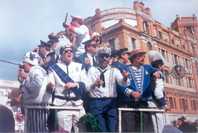Carnival of Cádiz
Los Carnavales is one of the best-known carnivals in Spain. The whole city participates in the carnival for more than two weeks each year, and the presence of this fiesta is almost constant in the city because of the rehearsals, recitals, and contests held throughout the year.
It is a widely held opinion that the city of Cádiz is blessed with the wittiest people in Spain,[citation needed] so it is not surprising that the main characteristics of the carnival in Cádiz are the acerbic criticisms, the droll plays on words, stinging sarcasm, and the irreverence of parody. While some carnivals, elsewhere in the world, stress the spectacular, the glamorous, or the scandalous in costumes, Cádiz distinguishes itself with the sheer cleverness and fertile imagination of its carnival attire. It is traditional to paint the face as a humble substitute for a mask.
It is easy to get involved in the fiesta even if one is a visitor and knows no Spanish. On Saturday, everyone wears a costume, which, many times, is related to the most polemical aspects of the news. However, the Carnival of Cádiz is most famous for the satirical groups of performers called chirigotas. Their music and their lyrics are in the center of the carnival.
Musical groups
The most famous groups are the chirigotas, the choirs, and the comparsas.
The chirigotas are well-known witty and satiric groups that train for the whole year to sing about politics, topics in the news, and everyday circumstances, while all of the members wear identical costumes. There is an official competition in Teatro Falla, where many of them compete for a group award. Their songs are all original compositions and are full of satire and wit. Each chirigota – whether a professional group or one made up of family members, friends or colleagues – has a wide repertoire of songs. They sing in the streets and squares, at improvised venues like outdoor staircases or portals, and in established open-air tablaos (tableaux) organized by the carnival clubs.
The choirs (coros) are larger groups that travel through the streets on open flat-bed carts or wagons, singing, with a small ensemble of guitars and lutes. Their characteristic composition is the "Carnival Tango", and they alternate between comical and serious repertory, with special emphasis on lyrical homages to the city and its people. The costumes are, by far, the most sophisticated and elaborate of all.
[ Other groups can be found in the streets: the quartets (cuartetos), that, oddly, can be composed of five, four, or three members. They do not bring a guitar, only a kazoo and two sticks, that they use to mark the rhythm. They use set-piece theater scenes (pre-written skits), improvisations, and music, and they are purely comical.
The minimalist carnival groups in Cádiz are the romanceros, perhaps the oldest, and, certainly, the most invariant carnival representation in Cádiz throughout history. A romancero is a single costumed person who brings a big easel on which posters help him to tell a story with images. The romancero recites humorous verses while pointing at aspects of the pictures and drawings with a long stick.

Musical forms
Specific musical forms have evolved at the Carnival of Cádiz over the years. In the beginning, popular music was used, and tropical rhythms were mixed with popular European dances and songs; only the lyrics changed. Near the end of the nineteenth century, the musical identity of the Carnival was already mature, and, although most of the names (tango, pasodoble, couplet, etc.) are shared with other musical forms around the world, their melodies, rhythms, and character are unmistakably original.
- The Presentation is the first piece sung to present the characterisation of the group, called its tipo. The style of the music is absolutely free and unstructured. It can take the form of a well-known form, an original composition, or even a spoken-word recitation.
- The Couplet is sung by the chirigotas, comparsas, choirs, and quartets. They are short satirical songs with a refrain that is always related to the costume and the characterisation (tipo) of the group.
- The Pasodoble is a longer song without a refrain, and it is usually (but not always) serious, criticising something that happened during the previous year or rendering an homage to someone. They are sung by the comparsas and the chirigotas.

- The Tango, with its characteristic gaditano rhythm is sung only by the choirs, accompanied by their orchestras, and they are mostly poetical compositions.
- The Potpourri, sung by all of the groups, changing the lyrics of well-known songs of the year or any other kind of music, sometimes depending on the group's tipo.
Beside these, other musical forms, including short improvisations and theatrical skits are featured, mostly by the so-called illegal chirigotas, murgas, or callejeras, that don't submit to any rule or contest. They just roam the streets singing and performing as they wish.
The contests
The best known contest among chirigotas, choirs, comparsas, and quartets in Cádiz is the 'Official Contest' at the Gran Teatro Falla, that finishes just before the first Saturday of Carnival. It is broadcast by the regional television and radio stations. Other contests take place before, during, and after the Carnival, usually organized by institutions and private clubs, and their venues are open tablaos in the public squares (plazas) of the city.
External links
| Wikimedia Commons has media related to Carnival of Cádiz. |
| ||||||||||||||||||||||||||||||||
